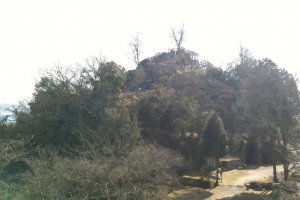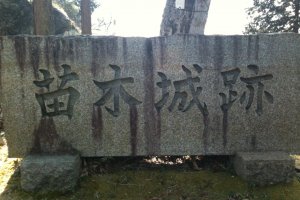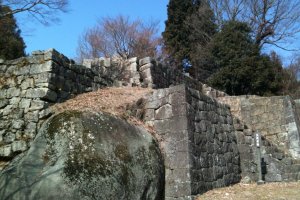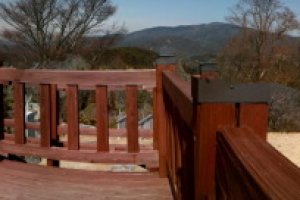After many long cold wet days spring had peaked its head up to let the sun shine down on the Kiso river valley. It was a perfect day to be outside and I didn’t want to return to my office. So after picking up some food, I ventured to Naegi castle ruins. I hadn’t been there in eleven years and felt like it would be a perfect location to eat lunch and relax. When going north on route 257 toward Gero, as you cross the Naegi Bridge you can see the ruins sitting perched above. Every time I pass it on the way to work, I wonder, “what did it look like sitting perched on that ridge?”
There are several ways to get up to the ruins with the easiest being a road located behind the castle museum but there are paths through the forests that wind around the base. The current gravel which road climbs gently hugged by a stone wall and forests had actually been the main access path when the castle was active. After about five minutes I reached the remains of a guard house where the gravel road ends and a cobble stone one begins.
It was only after a few more moments that I was standing in front of the wall of the outer wall. I am always in awe of how stone walls like this were built. Today we construct using heavy machinery but to think about looking for the right stones to place in the right location to build a huge wall and make it sturdy just boggles my mind. In many cases peasants were forced to carry rocks up to the castle base and build the walls. The Naegi Castle outer wall stands about ten meters high and has a space of what had been a guard house on the corner of parapets.
Many castles built in the warring states period were small and built on mountains for defense. Later, during more peaceful times, larger castles like Matsumoto and Osaka were built on plains. Naegi Castle, built by Toyama Naokado in 1532, was a sprawling red wooden facility constructed on top of a bluff looking down on the Kiso River. It could only be approached effectively by opposing armies from the west through dense forests and narrow paths. They used the boulders on the bluff to build walls. It was built in a rush and I figured that life in these castles was not elegant nor regal like those in Himeji or Nagoya. I started up a switch-back path to the top where original building had stood. It was getting hot and some old ladies passed me (reminder: exercise is good).
I reached the top where there is now an observation deck that outlines how the castle had stood. There I sat to eat my lunch and take in the view; Mount Ena, the entire Kiso River valley from Magome to Ena and north to snow capped Mount Ontake.
Once the Meiji period started, Japan was changing and castles were no longer needed. In Meiji 4 (1871) Naegi castle was dismantled and its wood was sold off in an auction. All that remains today are the stone walls and a part of the main gate (mon) on display at the Castle Museum.
Having finished my lunch, I returned to my car and back to the office thinking about how Naegi castle ruins was a symbol of the change from feudal Japan to modern Japan.
































